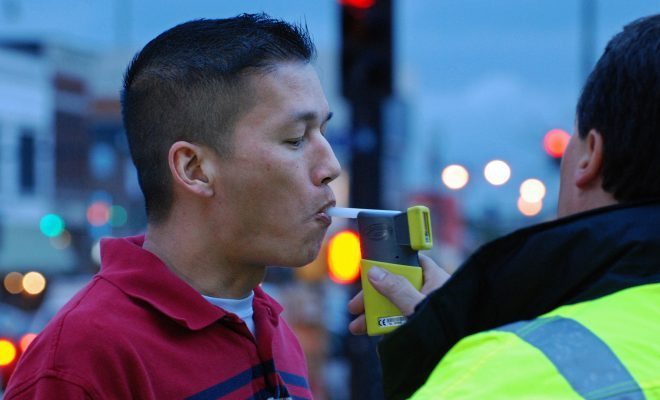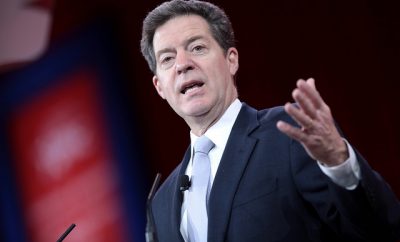 Image courtesy of [KOMUnews via Flickr]
Image courtesy of [KOMUnews via Flickr]
Health & Science
Breathalyzers in Cars? Changes in American Alcohol Policies
Tumultuous alcohol regulations speckle America’s past. Prohibition alone demonstrates our sometimes love/hate relationship with liquor. Some people loved alcohol enough to succumb to criminal behavior. Others hated it enough to dream of scourging it completely from the nation. Extreme feelings on both sides only led to fleeting Prohibition policies, blemishes on the Constitution, and a case study in alcohol regulation.
Today, we enjoy more balanced alcohol policies, but the system has yet to achieve the perfect balance of freedom, safety, and economic gain. From a public health perspective, alcohol consumption still presents a regulatory challenge in avoiding preventable alcohol-induced illness and death. Alcohol has unflattering ties to illness, death, and economic burden. Every year in the United States, alcohol consumption causes 1.6 million hospitalizations and 80,000 deaths. Alcohol-related liver cirrhosis alone kills 26,000 a year.
Many interventions place focus on the individual, with programs to treat heavy drinkers or educate people who might become heavy drinkers. Unfortunately, many accidents result when habitually moderate drinkers engage in uncharacteristically risky behavior. To make sure everyone benefits from interventions, many experts seek changes in alcohol regulations that could benefit the entire population. Some recent studies have yielded compelling results on how increasing taxes and adding breathalyzers to cars could yield enormous benefits to our overall well-being.
Regulation of Alcohol in the U.S.
You can strut around certain streets of Savannah, Georgia clutching an open container with no questions asked. Try that in any city in Virginia and you could face misdemeanor charges. Alcohol policies vary–sometimes dramatically–from state to state.
Alcohol regulations fall into four major subject areas:
- How alcohol is sold and distributed
- How alcohol is purchased and served
- Taxes, usually in the form of excise taxes on wine, beer, and hard liquor
- Blood alcohol content (BAC) laws for operating cars and machinery
Recent studies on the effects of taxes and BAC laws scrutinize current policies and call attention to possible changes. Keep reading to learn about the findings and how they could mix things up.
Higher Alcohol Taxes
One action that could potentially reduce alcohol-related deaths and boost the economy? Sounds like a great idea. Unfortunately, the idea is raising taxes, which immediately puts a sour taste in many mouths. Unpopular or not, the researchers assessing the relationship between alcohol and taxes have found tax increases could yield major benefits.
Increasing Taxes Decreases Alcohol Consumption.
Raising alcohol taxes decreases alcohol consumption, and therefore indirectly reduces alcohol-related disease and death. Research has proven many times the inverse relationship between alcohol consumption and higher taxes and prices. Compared with other prevention policies, taxation tops the list of the most effective ways to reduce drinking. Models have found increasing alcohol taxes could reduce alcohol-related deaths by about 35 percent, lower crashes by 11 percent, and even reduce transmission of sexually transmitted diseases by 6 percent.
Increasing Taxes Could Actually Create, Not Destroy, Jobs
People who oppose an increase in alcohol taxes often cite job loss and other economic concerns to justify their positions. But researchers have found that the opposite might be true, and increased alcohol taxes could actually stimulate the economy. Researchers from University of Illinois at Chicago and the Center on Alcohol Marketing and Youth (CAMY) at the Johns Hopkins Bloomberg School of Public Health created an online tool that tests how different alcohol tax rates could impact the economies of all 50 states. According to the model, a $0.05 alcohol tax increase in California could create about 21,500 jobs if the tax revenue goes into the government’s general fund. You can check out the tool here and even find out what increased alcohol taxes could do in your state.
Let’s give a possible increase in alcohol taxes some perspective. Alcohol taxes have pretty much avoided being adjusted for inflation since the 1950s. Since alcohol taxes didn’t adjust with the rest of the economy, in relative terms alcohol costs significantly less than it did in the 1950s. Take beer for example; most states calculate beer taxes per quantity, not based on price. By the year 2000, state beer taxes amounted to relatively about a 1/3 of what they were in 1968 as inflation spiked beer prices but taxes stayed stagnant. While some states adjusted for inflation, most states saw tax profit dwindle by over 50 percent since 1968.
That’s why Alexander Wagenaar, a professor at University of Florida, believes taxes should be raised and automatically adjusted for inflation. He estimates that every drink consumed costs society about $1.90 in healthcare and other burdens, but points out that alcohol consumers aren’t responsible for the extra costs incurred by their actions.
Will it happen?
Any attempts to raise taxes on alcohol have been met with firm opposition from liquor lobbies and the hospitality industry. As a result, most attempts at increasing alcohol taxes have failed, at least 335 out of 364 major attempts since 2001 in New Mexico, Minnesota, Maine, and Hawaii, just to name a few. In 2012, it’s estimated that the liquor industry spent $16 million on political candidates, solidifying their place in regulatory affairs.
Mandatory breathalyzers in our cars?
Had enough of grim DUI-warning commercials and high school “Grim Reaper” days? One policy could put an end to them by physically stopping would-be drunk drivers from starting their cars. One possible alcohol intervention involves installing alcohol ignition interlocks (a.k.a in car breathalyzers) that connect to the car’s ignition and lock it if the driver’s BAC is above a pre-set limit. This might seem extreme, but shine a spotlight on the problems with alcohol-involved motor vehicle crashes (AI-MVCs) and you’ll see why it’s appealing from a policy angle.
AI-MVCs rank as a major public health threat mostly because the dangerous actions of a few can end up hurting many innocent people. Awareness campaigns and laws have decreased the problem since the 1980s, but in 1994 AI-MVCs accounted for 30 percent of all traffic fatalities and since then that percentage hasn’t really budged.
Policies like BAC limits, zero tolerance laws, and license suspension work, but they place the burden of finding and penalizing perpetrators in the hands of police officers. Without a magical drunk radar, this means some people slip through and cause devastation. Some estimates find that repeat offenders often drive drunk as many as 80 times before they’re discovered and apprehended. Even license suspensions don’t stop them, as 50 percent to 75 percent of offenders keep on driving anyway.
Interlock devices cause prevention-minded experts to salivate at the idea of nipping fatal accidents in the bud. But would interlock devices actually help in the real world?
In 2008, the National Highway Traffic Safety Administration (NHTSA) started a five year test to determine the viability and effectiveness of widespread use of the devices. The Driver Alcohol Detection System for Safety (DADSS) program sought to find out if mandatory adoption policies would have an impact on fatal and non-fatal AI-MCVs and if they could decrease economic costs associated with AI-MCVs.
Here’s what they found out:
Interlock devices would prevent deaths and injuries:
Using a 15 year implementation model, the DADSS program estimated that 59,000 (83 percent) deaths and 1.25 million (84 percent-88 percent) of nonfatal injuries could be prevented.
Interlock devices would reduce AI-MCV costs:
Again, assuming a 15 year implementation model, costs associated with fatal injuries could be reduced by $260 billion and costs associated with nonfatal injuries could be reduced by $83 billion. In perspective, if the devices each cost $400 and worked 100 percent of the time, the reduction in injury costs would outweigh the implementation cost after 3 years.
A required interlock device program has already been implemented in France, the wine mecca of the world. Drivers in France need to have breathalyzers on hand or face fines. After implementing the program, France went from having one of the highest alcohol-related traffic fatalities in the world to having one of the lowest.
Will it happen?
The researchers acknowledged that mandatory interlock devices would be a drastic change, would take many years to implement, and would need to pass through the National Highway Traffic Safety Administration as a new safety standard. They recommend strengthening current policies in the interim, such as having all states require interlocks among first time DUI offenders, requiring the device use for longer periods of time, and requiring their use in the pre-conviction time frame. The DADSS found the public receptive to the idea, with 64 percent of people surveyed saying they thought it was a good idea.
Prevention instead of Punishment
State alcohol regulations change constantly. With an alcohol tax system that’s stuck in the 1950s and an AI-MCV rate that hasn’t budged since 1994, more changes are certainly in order. New policies would shift our alcohol intervention system from one of punishment, to one of prevention.
If either of these ideas seem extreme to you, remember that there are already some odd alcohol-related laws on the books. For example, in Massachusetts, discounted alcohol, even during happy hour, is prohibited. When dining at a restaurant in Utah, all alcohol bottles on display must be empty. We’ve endured these and other strange alcohol laws throughout the history of the United States. Surely interventions that could reduce alcohol-related fatalities, disease, and injuries will prove more palatable to many Americans.
Resources
Primary
Additional
Science Daily: Alcohol Taxes Can Improve Health, Lead to More Jobs
Mothers Against Drunk Driving: Ignition Interlock Frequently Asked Questions
Pew Charitable Trusts: Liquor Lobby Fights Off Tax Increases on Alcohol
Public Health Law Research: Raising Alcohol Tax Levels to Reduce Drinking
Yale Law School: Liquor Laws and Constitutional Conventions: A Legal History of the 21rst Amendment








Comments